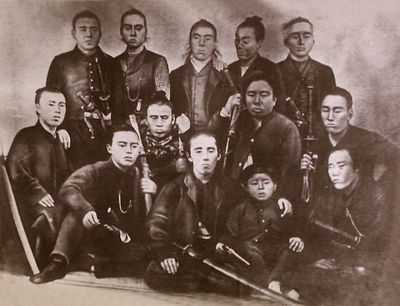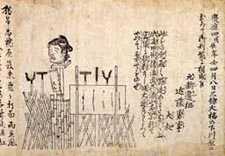Battle of Kōshū-Katsunuma
| ||||||||||||||||||||||||||||||
The Battle of Kōshū-Katsunuma (甲州勝沼の戦い Kōshū-Katsunuma no tatakai) was a battle between pro-Imperial and Tokugawa shogunate forces during the Boshin War in Japan. The battle followed the Battle of Toba-Fushimi on 29 March 1868 (Gregorian calendar).
Prelude

After defeating the forces of the Tokugawa shogunate at the Battle of Toba-Fushimi, the Imperial forces (consisting of the feudal armies of Chōshū, Satsuma and Tosa domains) split into three columns, which progressed northeast towards the Tokugawa capital of Edo up each of the three main highways: Tōkaidō (road), Nakasendō and Hokurikudō.
Meanwhile, Kondō Isami, leader of the Shinsengumi, withdrew to Edo after the Battle of Toba-Fushimi. Once back in Edo, he met with Shogunal military commander Katsu Kaishū. Kondō created a new unit based on the surviving remnants of the Shinsengumi, called the Kōyō- chimbutai (甲陽鎮撫隊), and they departed Edo on 1 March.
The battle
The Imperial army reached the Tokugawa stronghold of Kofu, Yamanashi first, and occupied it with a struggle. The Imperial army then met the Shogunal forces in battle at Katsunuma (now a part of Kōshū, Yamanashi) on 29 March. Outnumbered 10:1, the Shogunal forces were defeated with 179 casualties. The survivors, including Kondō, attempted to flee to Aizu via Sagami Province, which was still controlled by Tokugawa hatamoto loyalists.
Consequences
Kondō Isami narrowly escaped from this battle, but was captured soon after at Nagareyama, Chiba. He was beheaded by the new government at Itabashi a short time later. The Battle of Kōshū-Katsunuma was the last significant military action in central Honshū during the Boshin War, and the death of Kondō Isami further demoralized Tokugawa supporters, contributing to the surrender of Edo Castle without bloodshed the following year.
Further reading
- Aikawa Tsukasa and Kikuchi Akira. Shinsengumi Jitsuroku. Tōkyō: Chikuma-Shōbō, 1996.
- Kikuchi Akira. Shinsengumi Hyakuichi no Nazo. Tōkyō: Shin Jinbutsu Ōraisha, 2000.
- Nagakura Shinpachi. Shinsengumi Tenmatsu-ki. Tōkyō: Shin Jinbutsu Ōraisha, 2003
- Shinsengumi Saitō Hajime no Nazo. Tōkyō: Shin Jinbutsu Ōraisha, 2003.
- Yamakawa Kenjirō. Aizu Boshin Senshi. Tōkyō: Tōkyō Daigaku Shuppankai, 1931.

